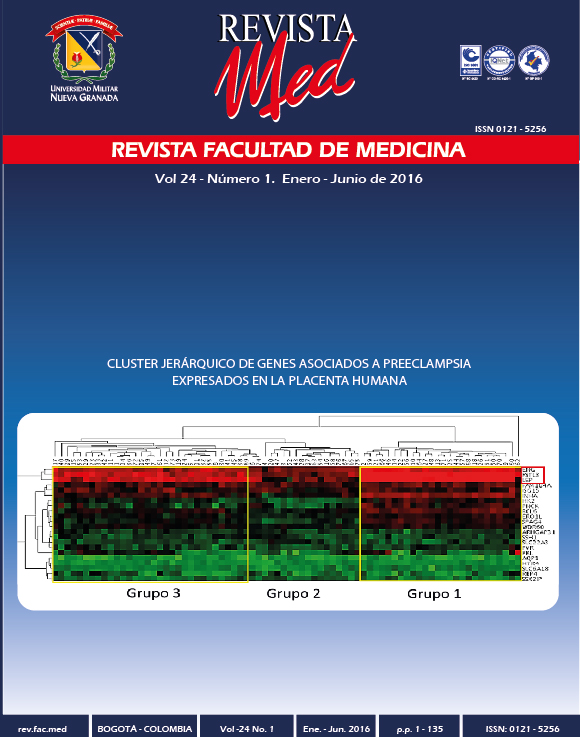Patógenos da infecção do trato urinário e fatores de hospedagem na população pediátrica em um hospital de quatro níveis Bogotá-Colombia entre 2006 e 2012
Resumo
Introdução: A infecção do trato urinário é uma das infecções bacterianas mais comuns em crianças (representando 7%), é diagnóstico precoce e tratamento poderia ter impacto em complicações. Essa é a razão pela qual o antibiótico empírico é utilizado para o tratamento, é dirigida para os microorganismos mais freqüentes. Na revisão do antibiograma, a sensibilidade de Escherichia coli (E. coli) relatada em 2002 no Hospital Militar Central foi satisfatória (86%) para continuar a mesma linha de tratamento (cefalotina) em crianças com infecções febris do tracto urinário. Em muitos estudos nacionais e internacionais tem sido relatado um aumento na resistência a cefalosporinas de primeiro nível, com as conseqüentes mudanças no tratamento de primeira linha. No entanto, as mudanças na sensibilidade nos últimos anos em nosso Hospital Militar Central é desconhecida também,
Objetivo: Determinar as alterações na sensibilidade bacteriana em infecções urinárias e sua relação com fatores de reféns em pacientes pediátricos do Hospital Militar Central entre os anos 2006-2012.
Materiais e métodos: Estudo retrospectivo de corte transversal, incluindo crianças entre 0 e 14 anos desde janeiro de 2006 e dezembro de 2012, com diagnóstico confirmado de infecção do trato urinário com cultivo de urina positiva, dependendo do método de recolhimento. A recolha de dados incluiu microorganismo, sensibilidade e foram excluídos aqueles com informações incompletas, imunocomprometidos, com doenças oncológicas ou neurológicas. Resistência a antibióticos comuns e fatores residentes (idade, sexo, presença de febre, tratamento antibiótico prévio, doenças obstrutivas e refluxo urinário).
Conclusões: A sensibilidade global para cefalosporinas de primeiro nível é de 82%, o que é alto. e seguindo os fatores de risco analisados recomendamos: para infecção febril do tracto urinário recomendamos cefalosporinas de primeiro nível. Para infecções não febris recomendamos nitrofurantoína ou ácido nalidíxico. Se houver fatores de risco, programe o controle clínico com cultura de urina para mudar ou continuar o tratamento, porque eles têm mais risco de resistência.
Downloads
Referências
Hoberman A, Chao HP, Keller DM, Hickey R, Davis HW, Ellis D. Prevalence of urinary tract infection in febrile infants. J Pediatr. 1993; 123(1):17–23.http://dx.doi.org/10.1016/S0022-3476(05)81531-8
Shaw KN, Gorelick M, McGowan KL, Yakscoe NM, Schwartz JS. Prevalence of Urinary Tract Infection in Febrile Young Children in the Emergency Department. Pediatrics. 1998;102(2):e16.http://dx.doi.org/10.1542/peds.102.2.e16
Becker GJ. Reflux nephropathy: the glomerular lesion and progression of renal failure. Pediatr Nephrol 1993; 7(4):365–369.http://dx.doi.org/10.1007/BF00857540
Clark CJ, Kennedy WA, Shortliffe LD. Urinary Tract Infection in Children: When to Worry. Urol Clin N Am. 2010; 37(2):229–241.http://dx.doi.org/10.1016/j.ucl.2010.03.009
Prajapati BS, Prajapati RB, Patel PS. Advances in management of urinary tract infections. Indian J Pediatr 2008; 75(8):809–814.http://dx.doi.org/10.1007/s12098-008-0152-0
Quigley R. Diagnosis of urinary tract infections in children. Curr Opin Pediatr 2009; 21(2):194–198.http://dx.doi.org/10.1097/MOP.0b013e328326f702
Bhat RG, Katy TA, Place FC. Pediatric Urinary Tract Infections. Emerg Med Clin North Am. 2011; 29(3):637–653.http://dx.doi.org/10.1016/j.emc.2011.04.004
National Collaborating Centre for Women's and Children's Health (UK). Urinary Tract Infection in Children: Diagnosis, Treatment and Long-term Management. National Institute for Health and Clinical Excellence: Guidance. London: RCOG Press; Aug 2007.
Huertas RM, Reyes G. Estudio descriptivo de la respuesta clínica a la cefalotina en el tratamiento de la pielonefritis aguda en ni-os de 3 meses a 15 a-os en el Hospital Militar Central entre los a-os 1995 y 2001. Tesis posgrado. Bogotá: Repositorio Universidad Militar Nueva Granada. 2001
Lozano JM, Domínguez M, Marrugo T. Hallazgos paraclínicos y microbiológicos en infección urinaria en pediatría en el Hospital Universitario de San Ignacio. Universitas Med. 2000; 41:194-199.
Lozano JM, Parada MF, Bohórquez MC. Sensibilidad antibacteriana en infección urinaria en el Hospital Universitario de San Ignacio de Bogotá. Pediatria. 2003; 38:289-295.
Casta-o I, Gonzalez C, Buitrago ZY, De Rovetto C. Etiología y sensibilidad bacteriana en infección urinaria en ni-os. Hospital Infantil Club Noel y Hospital Universitario del Valle, Cali, Colombia. Colomb Med. 2007; 38(2):100-106
Bautista-Amorocho H, Súarez-Fragoso ND, Támara-Urrutia AM, Rodríguez-Villamizar LA. Etiología y susceptibilidad bacteriana a los antimicrobianos en ni-os con infecciones urinarias. Rev Mex Pediatr. 2009; 76(2):70-74.
Hoyos A, Serna L, Atehortúa P, Ortiz G, Aguirre J. Infección urinaria de la comunidad en pacientes pediátricos de la Clínica Universitaria Bolivariana. Etiología, presentación clínica, factores de riesgo y respuesta clínica a la terapia empírica inicial. Medicina UPB. 2010; 29(2):89-98.
Gallardo L, Maga-a M, Andrade HG, Jimenez MJ, Sánchez K, Fragoso LE. Resistencia a fármacos empleados en infección de vías urinarias en pacientes de primer contacto en una Unidad de Medicina Familiar del IMSS. Enf Inf Microbiol. 2008; 28 (1):13-18.
Shaikh N, Morone NE, Bost JE, Farrell MH. Prevalence of Urinary Tract Infection in Childhood A Meta-Analysis. Pediatr Infect Dis J. 2008; 27(4):302–308.http://dx.doi.org/10.1097/INF.0b013e31815e4122
Foxman B. Epidemiology of urinary tract infections: incidence, morbidity, and economic costs. Am J Med. 2002; 113(1A):5–13.http://dx.doi.org/10.1016/S0002-9343(02)01054-9
Zorc JJ, Levine DA, Platt SL, Dayan PS, Macias CG, Krief W, Schor J, Bank D, Shaw KN, Kuppermann N; Multicenter RSV-SBI Study Group of the Pediatric Emergency Medicine Collaborative Research Committee of the American Academy of Pediatrics. Clinical and demographic factors associated with urinary tract infection in young febrile infants. Pediatrics. 2005; 116(3):644–648.http://dx.doi.org/10.1542/peds.2004-1825
Yolbas I, Tekin R, Kelekci S, Tekin A, Okur M, Ece A, Gunes A, Sen V. Community-acquired urinary tract infections in children: pathogens, antibiotic susceptibility and seasonal changes. European Review for Medical and Pharmacological Sciences. 2013; 17:971-976
Alonso B, Bernadá M, Pereda M, Traversa M, Lechini R, Mari-o S, Perdomo V. Infección urinaria en ni-os: agentes patógenos y sensibilidad antibiótica. Arch Pediatr Urug 2001; 72(4): 268-273
Alsammani MA, Ahmed MI, Abdelatif NF. Bacterial Uropathogens Isolates and Antibiograms in Children Under 5 Years of Age. Med Arh. 2014; 68(4): 239-243http://dx.doi.org/10.5455/medarh.2014.68.239-243
Subcommittee on Urinary Tract Infection, Steering Committee on Quality Improvement and Management. Urinary Tract Infection: Clinical Practice Guideline for the Diagnosis and Management of the Initial UTI in Febrile Infants and Children 2 to 24 Months. Pediatrics. 2011;128 (3):595-610;http://dx.doi.org/10.1542/peds.2011-1330
Saadeh SA, Mattoo TK. Managing urinary tract infections. Pediatr Nephrol. 2011; 26(11):1967–1976.http://dx.doi.org/10.1007/s00467-011-1801-5
Price E, Pallett A, Gilbert RD, Williams C. Microbiological aspects of the UK National Institute for Health and Clinical Excellence (NICE) guidance on urinary tract infection in children. J Antimicrob Chemother 2010; 65:836–841http://dx.doi.org/10.1093/jac/dkq045
Heffner VA, Gorelick MH. Pediatric Urinary Tract Infection. Clin Ped Emerg Med. 2008; 9(4):233-237.http://dx.doi.org/10.1016/j.cpem.2008.09.009
American Academy of Pediatrics. Practice parameter: the diagnosis, treatment, and evaluation of the initial urinary tract infection in febrile infants and young children. Pediatrics. 1999; 103(4 Pt 1):843–852.
Hoberman A, Wald ER, Hickey RW, Baskin M, Charron M, Majd M, Kearney DH, Reynolds EA, Ruley J, Janosky JE. Oral versus initial intravenous therapy for urinary tract infections in young febrile children. Pediatrics. 1999; 104(1 Pt 1):79–86.http://dx.doi.org/10.1542/peds.104.1.79
Beetza R, Westenfelderb M. Antimicrobial therapy of urinary tract infections in children. Int J of Antimicrob Agents 2011; 38:42–50http://dx.doi.org/10.1016/j.ijantimicag.2011.09.006
Ammenti A, Cataldi L, Chimenz R, Fanos V, La Manna A, Marra G, Materassi M, Pecile P, Pennesi M, Pisanello L, Sica F, Toffolo A, Montini G. Febrile urinary tract infections in young children: recommendations for the diagnosis, treatment and follow-up. Acta Pædiatrica. 2012;101(5):451-7http://dx.doi.org/10.1111/j.1651-2227.2011.02549.x
Hewitt IK, Montini G. Pediatric febrile urinary tract infections: the current state of play. Ital J Pediatr. 2011;37:57-59http://dx.doi.org/10.1186/1824-7288-37-57
Tullus K. What do the latest guidelines tell us about UTIs in children under 2 years of age. Pediatr Nephrol. 2012;27(4):509-511http://dx.doi.org/10.1007/s00467-011-2077-5












